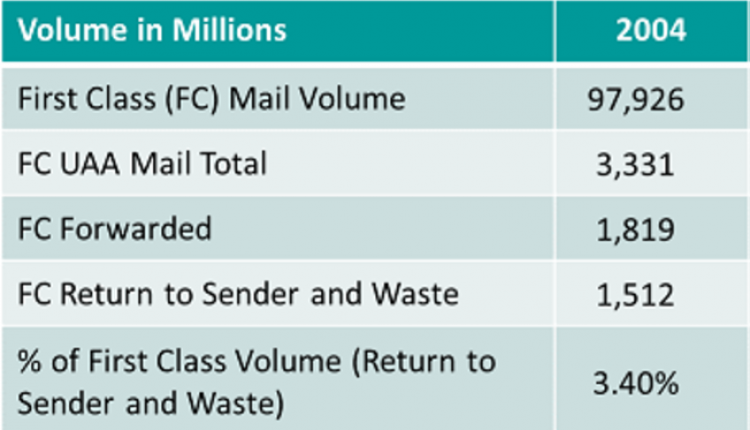A personalized piece of direct mail can still yield an appreciable response rate when compared to other forms of direct marketing such as email. According to a June 2012 study from the Direct Marketing Association, the average response rate for direct mail was 3.4% whereas the average response rate for email was 0.12%. That is a significant difference and one that underscores the value a physical mailpiece has for overall messaging.
However, it is easy to forget that part of the reason mail works so well is that it is personable. With the USPS now continuing to push its Every Door Direct Mail program and even considering expanding the concept, it would be wise to consider leveraging the latest in software and data to make the mail more personal again. Fortunately, there are numerous sources and technology available for direct marketers to consider when crafting their message.
The first step is to start with a good prospecting list. Often this could be your own customer list. As noted in earlier Software Byte columns, it is vital to keep this list complete, correct, and current. So make sure you are cleansing and updating the names and addresses at least every 95 days pursuant to the USPS requirement. Best practice, though, recommends updating the list at least every 30 days.
If you are renting a list, ask them how often they cleanse the data. You may also want to ask them for a copy of the latest PS3553, the USPS CASS Summary Report. This report has some excellent statistical information including the Qualitative Statistical Summary section on the bottom that can provide a snapshot of the quality of the list.
Once you have a clean list, it's time to merge/purge the data against other data sources. For example, you might want to match the list against a prison suppression or deceased list using a purge feature. This will allow you to remove undesirable records and not only save postage, but also improve the overall response rate. You can also use demographic information in some cases to also suppress out undesirable addresses.
The Direct Marketing Association also provides a list for their members to suppress records from people who have asked to not be included in certain types of promotions. Leveraging this DMA Suppression List, part of DMAchoice, is the responsible approach to avoiding a national do-not-mail legislated list.
Merging data means more than just removing duplicate records. It also means matching and consolidating data to form a better, more complete view of the prospect. For example, some software solutions provide enhanced merge/purge functionality that can perform complex matching such as householding. Householding is usually defined as two or more records that have a matching base address, but different occupants. This classic example is a husband and a wife who have individual records in a common database and the mailer wants to merge their records into one to address both of them.
Enhanced merge/purge tools generally use "fuzzy" matching, meaning that a percentage is applied for the match score. The software user would select the fields in the databases to match and then choose a percentage score to indicate a threshold for considering what constitutes a match.
In many cases, merging multiple records together should result in a single, more complete record. Software generally allows a user considerable control here as well with options such as choosing the first record found, last record found, the record with the last update applied, most populated fields, or highest priority record just to name a few examples.
With a complete and accurate list, we can now prepare the personalized message. However, here too we must be careful and not make it too personal or we will face a significant increase in postage. Most direct marketing pieces are mailed at Standard Mail rates. However, according to Domestic Mail Manual (DMM) 243 section 2.2, certain personalized pieces of information cannot be mailed at Standard Mail rate and must be mailed at First-Class Mail rate. This includes bills and statements of account or handwritten and typewritten matter. There is a line where the message can become too personalized, so mailers need to check the rules in the DMM to make sure they conform to Standard Mail rates if they want the discounted postage.
Finally, while personalized direct mail continues to prove an effective way to market goods and services on its own, it is substantially enhanced when combined with supportive channels. This includes mobile devices and QR codes. According to an InfoTrends report, a printed piece combined with a web landing page increased the response rate by 19%. That same print piece when combined with email increased the response rate by 28%. All three methods combined together as a multi-channel approach, the response rate increased by 34%.
Direct mail still continues to be a solid foundation for direct marketing. However, today's marketer needs to carefully leverage new data, evolving software solutions, and rapidly emerging technology together to achieve the highest response rates and overall return on investment.
Christopher Lien is Vice President, Software Marketing, Bell and Howell.
However, it is easy to forget that part of the reason mail works so well is that it is personable. With the USPS now continuing to push its Every Door Direct Mail program and even considering expanding the concept, it would be wise to consider leveraging the latest in software and data to make the mail more personal again. Fortunately, there are numerous sources and technology available for direct marketers to consider when crafting their message.
The first step is to start with a good prospecting list. Often this could be your own customer list. As noted in earlier Software Byte columns, it is vital to keep this list complete, correct, and current. So make sure you are cleansing and updating the names and addresses at least every 95 days pursuant to the USPS requirement. Best practice, though, recommends updating the list at least every 30 days.
If you are renting a list, ask them how often they cleanse the data. You may also want to ask them for a copy of the latest PS3553, the USPS CASS Summary Report. This report has some excellent statistical information including the Qualitative Statistical Summary section on the bottom that can provide a snapshot of the quality of the list.
Once you have a clean list, it's time to merge/purge the data against other data sources. For example, you might want to match the list against a prison suppression or deceased list using a purge feature. This will allow you to remove undesirable records and not only save postage, but also improve the overall response rate. You can also use demographic information in some cases to also suppress out undesirable addresses.
The Direct Marketing Association also provides a list for their members to suppress records from people who have asked to not be included in certain types of promotions. Leveraging this DMA Suppression List, part of DMAchoice, is the responsible approach to avoiding a national do-not-mail legislated list.
Merging data means more than just removing duplicate records. It also means matching and consolidating data to form a better, more complete view of the prospect. For example, some software solutions provide enhanced merge/purge functionality that can perform complex matching such as householding. Householding is usually defined as two or more records that have a matching base address, but different occupants. This classic example is a husband and a wife who have individual records in a common database and the mailer wants to merge their records into one to address both of them.
Enhanced merge/purge tools generally use "fuzzy" matching, meaning that a percentage is applied for the match score. The software user would select the fields in the databases to match and then choose a percentage score to indicate a threshold for considering what constitutes a match.
In many cases, merging multiple records together should result in a single, more complete record. Software generally allows a user considerable control here as well with options such as choosing the first record found, last record found, the record with the last update applied, most populated fields, or highest priority record just to name a few examples.
With a complete and accurate list, we can now prepare the personalized message. However, here too we must be careful and not make it too personal or we will face a significant increase in postage. Most direct marketing pieces are mailed at Standard Mail rates. However, according to Domestic Mail Manual (DMM) 243 section 2.2, certain personalized pieces of information cannot be mailed at Standard Mail rate and must be mailed at First-Class Mail rate. This includes bills and statements of account or handwritten and typewritten matter. There is a line where the message can become too personalized, so mailers need to check the rules in the DMM to make sure they conform to Standard Mail rates if they want the discounted postage.
Finally, while personalized direct mail continues to prove an effective way to market goods and services on its own, it is substantially enhanced when combined with supportive channels. This includes mobile devices and QR codes. According to an InfoTrends report, a printed piece combined with a web landing page increased the response rate by 19%. That same print piece when combined with email increased the response rate by 28%. All three methods combined together as a multi-channel approach, the response rate increased by 34%.
Direct mail still continues to be a solid foundation for direct marketing. However, today's marketer needs to carefully leverage new data, evolving software solutions, and rapidly emerging technology together to achieve the highest response rates and overall return on investment.
Christopher Lien is Vice President, Software Marketing, Bell and Howell.






